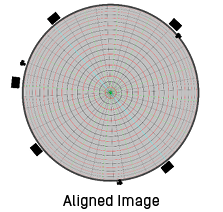Camera Based Auto Alignment of Warping and Blending of Multi-Channel Projections
In projection systems with multiple projectors it is hard or sometimes even impossible to adjust warping and blending parameters to create a seamless looking image manually. Furthermore, this system has to be maintained during operation to keep the image quality good. This means your customer would need well-trained technicians and again, keeping this system aligned manually is sometimes impossible.
Special projection scenarios like domes need content mapping and advanced parameters, like the head position of the visitors, which impact mapping and warping content on the screen surface. Withing a cluster of servers, there might be the need to sliced the high resolution content into pieces for each projector.
Warping, Blending, Masking, Slicing - Pixel Perfect
The Calibrator software takes care of all these tasks. The only additional hardware you need to install is a number of digital photo cameras that are able to “see” the entire screen surface. They can be located anywhere, either on top of the screen or integrated. There are no restrictions or limitations. For a typical dome shape screen you will need 3 cameras.
Blacklevel Compensation
Calibrator and Backstage are capable to compensate the different black levels that appear on the screen, caused by the remaining light output of projectors when they project black, especially noticeable in overlapping areas. The correction is camera based and can work with mixed digital & mechanical blending.
Mechanical & Digital Blending Combined
With Calibrator and Backstage, a mixed mechanical and digital blending can be created, reducing the complexity of the mechanical masks with an outstanding black and white level on screen.
Planar, Curved, Spherical, Dome, or 3D Model - Any Screen Shape
The projection system must be constructed in the software first. The 3D Model includes the screen (can be of any shape), projectors and cameras. If everything would have been built and placed in real as planned, you would have an aligned picture already after this construction phase – but this is theory. In fact, all buildings have tolerances and that’s where the camera based auto alignment starts its work: several test images are projected on each projector and the cameras take pictures of them. Our software analyses the offset and wrong warping of the projected images and perfectly adjusts warping and blending to have a seamless image on the screen shape.
Perfect Image by Pressing a Button
Since all projected images and big screen structures tend to move due to thermal influences, the picture in a dome must be calibrated from time to time. Dependent on the quality needs, the calibration can be done by simply pressing a button, even every day. This assures that all projected pixels match to each other and guarantees a perfectly aligned image during all time of operation.






